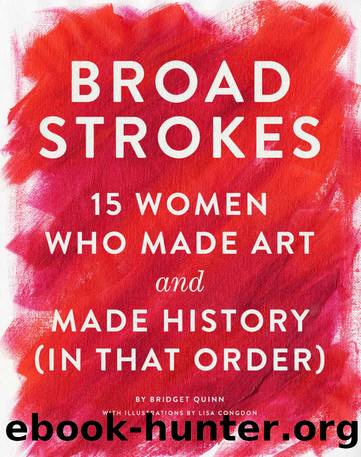Broad Strokes: 15 Women Who Made Art and Made History (in That Order) by Bridget Quinn

Author:Bridget Quinn [Quinn, Bridget]
Language: eng
Format: azw3
Publisher: Chronicle Books LLC
Published: 2017-03-07T00:00:00+00:00
Such creativity was a kind of birthright. Her father was eminent critic and historian Sir Leslie Stephen, whose first wife was the daughter of novelist William Make-peace Thackeray. Meanwhile, Vanessa and Virginiaâs own mother, Julia, was niece and subject of photography pioneer Julia Margaret Cameron and also the model for some Pre-Raphaelite painters, whose strong-boned, wavy-haired heroines she epitomized. Bellâs childhood was surrounded by artists, writers, and thinkers on all sides, though from earlier generations. âThe cruel thing,â wrote her sister, âwas that while we could see the future, we were completely in the power of the past.â
Widowers with children from previous marriages, Leslie and Julia had four together: Thoby, Vanessa, Virginia, and Adrian. At the death of Leslie Stephen in 1904 (Julia had died in 1895), the siblings stayed together. They set up house in an unfashionable London neighborhood called Bloomsbury, where Thobyâs Cambridge friends joined them in creating a lively gathering of influential artists, writers, and intellectuals who ultimately transformed British art and life.
The tomes written on the Bloomsbury Groupâthe name given their artful London cliqueâmay outweigh that of any other twentieth-century phenomenon, save World War II. To keep this account pithy and keep it to Bell, Iâll start with a quick chronology of Bellâs life, which reads as a litany of loss: The month Bell turned sixteen, her mother died of rheumatic fever (in our brief history of women artists, dead mothers are a terrible, recurring theme). Two years later, the death of her half-sister, Stella, forced Bell into the role of âwoman of the house.â Between balancing the household budget and serving tea at 4:30, she squeezed in art classes at the Royal Academy. The death of Sir Leslie liberated her, but the sibling paradise of Bloomsbury did not last. Two years later, the eldest, Thoby, succumbed to typhoid.
At the death of her beloved brother, Vanessa married his friend Clive Bell. They had two children, Julian and Quentin. At age twenty-nine, Julian was killed while serving as an ambulance driver in the Spanish Civil War. Bell almost did not survive his death. When four years later her sister put stones in her pockets and waded into the river Ouse, Bell more than understood the stoicism required of wrenching loss.
But Bellâs long and productive life was far from tragic. Her passions were deeply felt and abundant. Foremost were her children and her art, and maybe also love itself.
A multiplicity of love was helped along by husband Clive Bell, who insisted on an open marriage. To his credit, this openness was not for himself alone and extended to his wife, who soon took up with Englandâs preeminent art historian, Roger Fry. Unlike Clive, her lover was devastated when after a few years she fell for painter Duncan Grant, then lived with him in marriagelike coupledom for some forty years. Together they had a child, Angelica, who was raised as a Bell. Vanessa and Clive never divorced and remained congenial friends. Meanwhile, Vanessa quietly shared her love of Grant
Download
This site does not store any files on its server. We only index and link to content provided by other sites. Please contact the content providers to delete copyright contents if any and email us, we'll remove relevant links or contents immediately.
The Japanese by Christopher Harding(1086)
Watercolor With Me in the Forest by Dana Fox(755)
A Theory of Narrative Drawing by Simon Grennan(746)
Glittering Images: A Journey Through Art From Egypt to Star Wars by Camille Paglia(730)
The Story of the Scrolls by The Story of the Scrolls; the M(727)
Boris Johnson by Tom Bower(624)
This Is Modern Art by Kevin Coval(601)
The Art and Science of Drawing by Brent Eviston(594)
Frida Kahlo by Frida Kahlo & Hayden Herrera(589)
AP Art History by John B. Nici(578)
Banksy by Will Ellsworth-Jones(572)
War Paint by Woodhead Lindy(552)
Van Gogh by Gregory White Smith(550)
Scenes From a Revolution by Mark Harris(548)
Draw More Furries by Jared Hodges(548)
About Looking by John Berger(545)
Ecstasy by Eisner.;(539)
100 Greatest Country Artists by Hal Leonard Corp(526)
Young Rembrandt: A Biography by Onno Blom(517)
